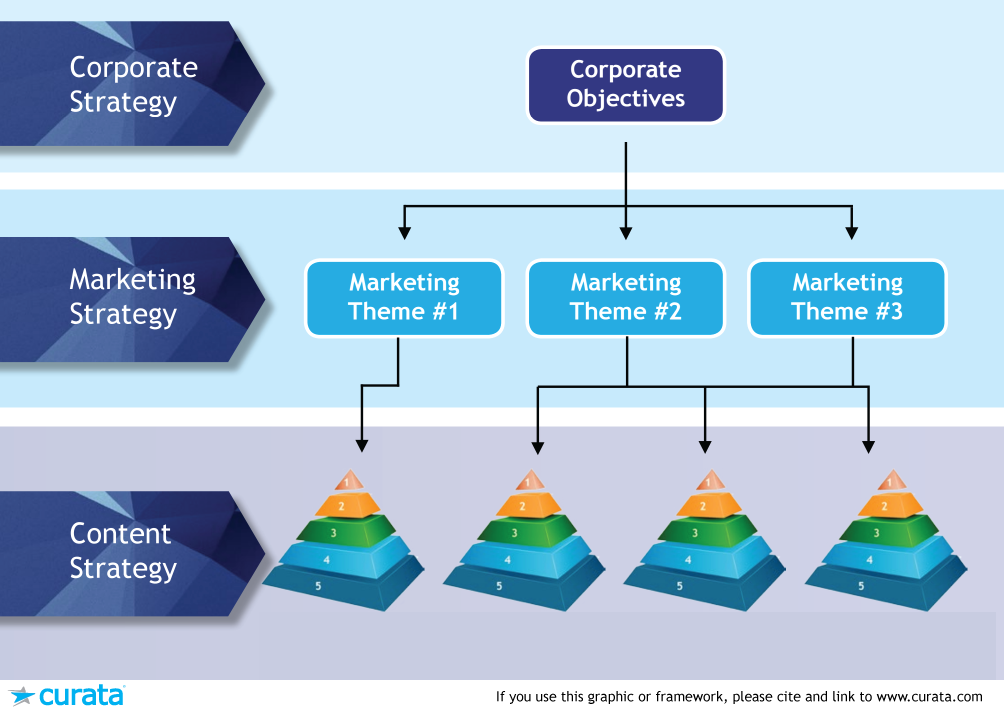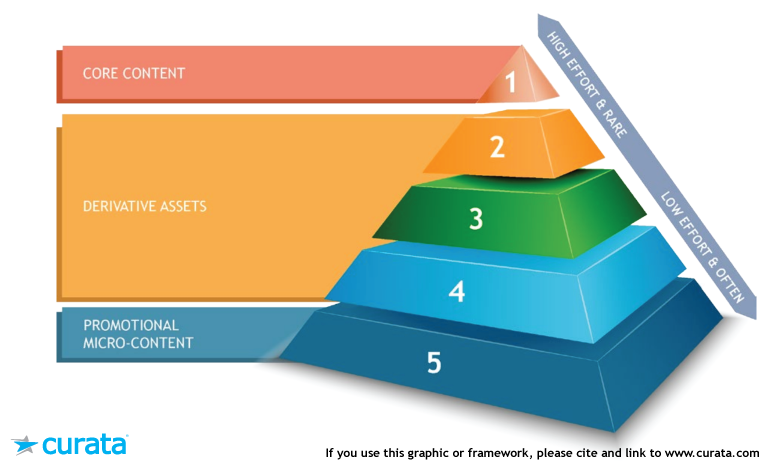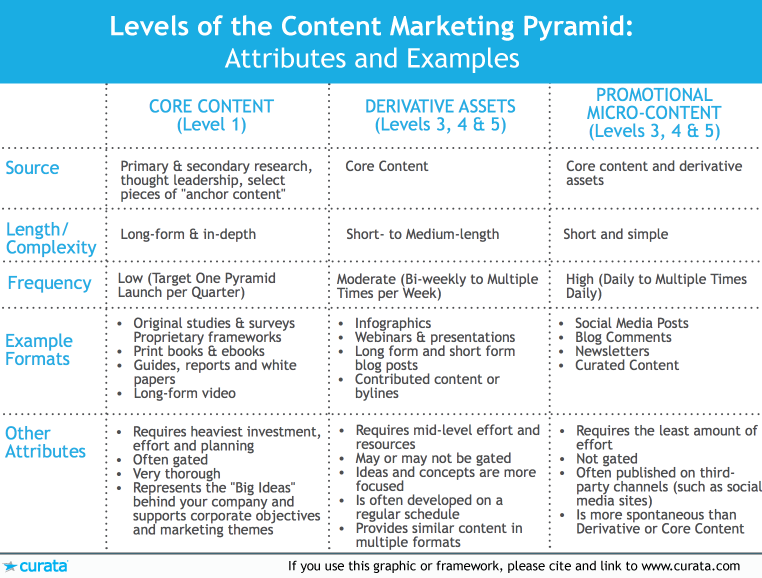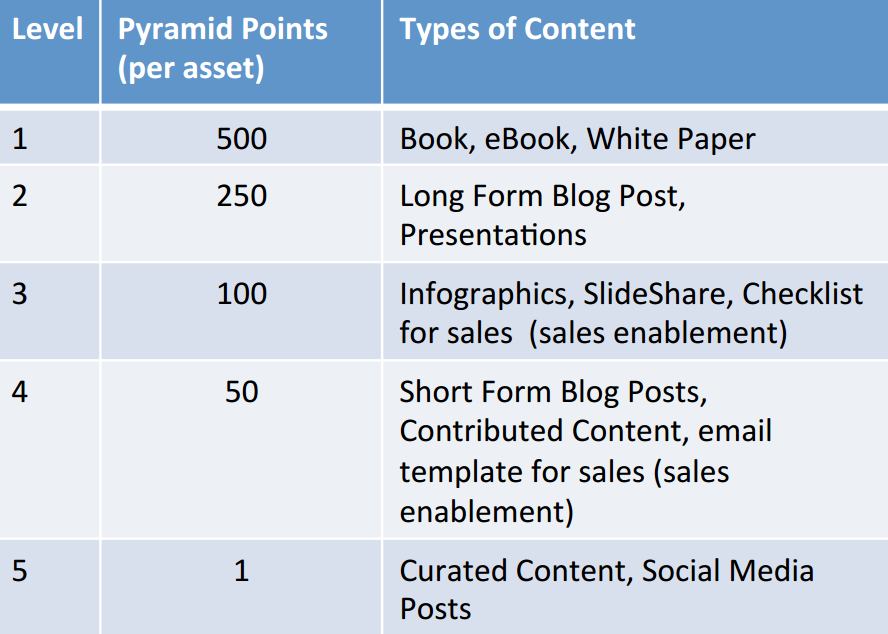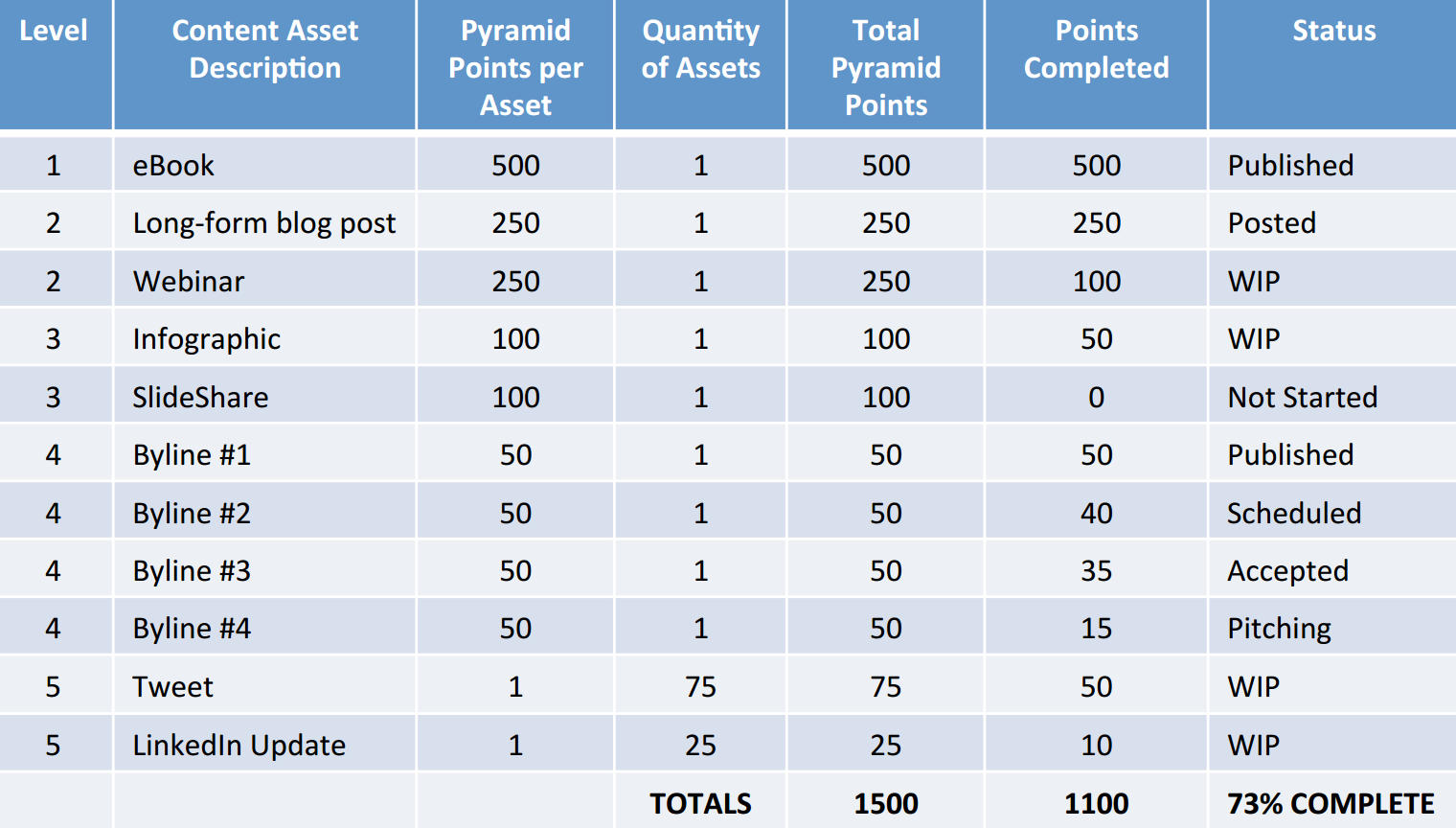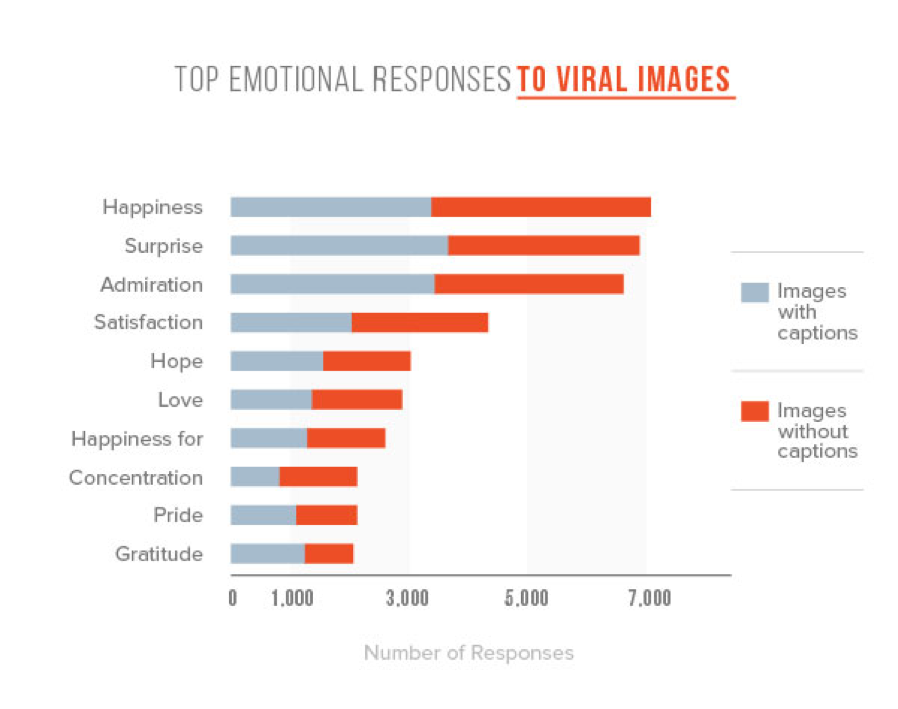Enter Curata’s Content Marketing Pyramid , a strategic framework enabling you to execute a content campaign, assuring optimal content consumption, reuse, and reach.
, a strategic framework enabling you to execute a content campaign, assuring optimal content consumption, reuse, and reach.
This hands-on guide teaches you what the Content Marketing Pyramid is, why it works, and how you can implement it within your organization.
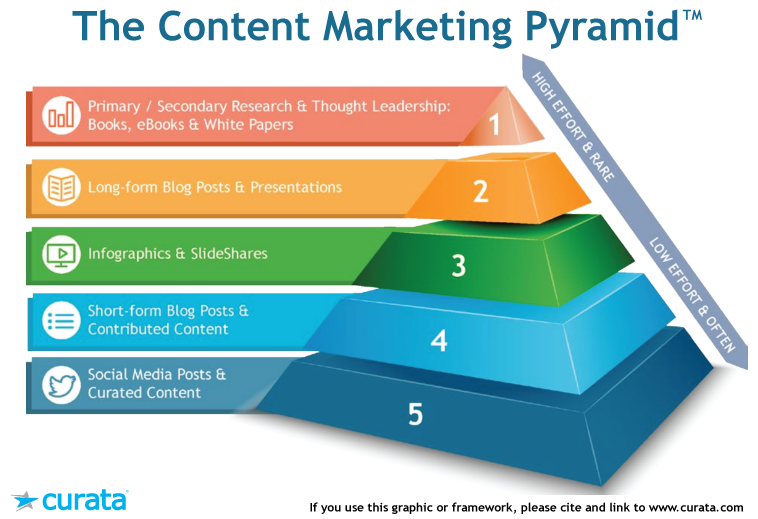
Why Use the Content Marketing Pyramid?
In addition to providing a documented content strategy, the Content Marketing Pyramid:
- Improves your focus with an organized strategy that establishes clear goals and priorities
- Increases your production capacity by making more efficient use of valuable resources
- Creates a predictable stream of successful content to engage your buyers and drive pipeline activity for marketing and sales
 DOUG KESSLER
DOUG KESSLERCo-Founder and Creative Director, Velocity Partners @dougkessler
“What happens when you create content without strategy? Usually, nothing. Content without strategy is like playing the lottery: who knows, you might win. Probably not. Ready, Fire, Aim!”
According to the 2017 CMI/MarketingProfs B2B Marketing Benchmark report, 60 percent of those with a documented strategy rate themselves highly in terms of content marketing effectiveness. This compares with 32 percent of those who have a verbal strategy. The Content Marketing Pyramid alleviates many headaches from ineffective content marketing. But if you operate without a smart framework it leaves you susceptible to the following consequences:
Chaos
You may be dealing with departments that operate in silos, a content strategy with no documented objectives, and a lack of communication between content creators.
How the Content Marketing Pyramid Can Help: This framework documents, centralizes, and coordinates all your content marketing efforts.
A Fractured Customer Experience
Readers experience inconsistent messaging and disconnected touch points. This leads to a lack of brand loyalty and dissatisfaction.
How the Content Marketing Pyramid Can Help: The Content Marketing Pyramid lends itself to cohesive messaging and centralized information.
 NEIL PATEL
NEIL PATELCo-founder of Crazy Egg, Hello Bar and KISSmetrics @neilpatel
“When you create content without a strategy you’ll find that you have tons of articles with little to no traffic. Roughly half of your time should be spent on strategy and marketing.” neilpatel.com
Waste
Because of the chaos and lack of communication, you’re constantly reinventing the wheel. When there’s little documentation, it’s easy to recreate similar pieces of content, instead of simply reusing or repurposing existing content.
How the Content Marketing Pyramid Can Help: This framework eliminates waste by streamlining the internal development process and ensuring every piece of content performs multiple roles across a variety of formats and channels.
Even if you aren’t experiencing any of the aforementioned consequences, content marketing is only about to get more competitive—and challenging. Take these stats for example:
- 70 percent of B2B marketers expect to create more content in 2017 versus last year, and 39 percent plan to increase their content marketing spend over the next 12 months. [CMI/MarketingProfs]
- In 2016, 42 percent of companies had an executive in their organization who was directly responsible for an overall content marketing strategy [Curata 2016 Content Marketing Tactics and Technology Study]
Since most marketers don’t have an unlimited budget, the best way to compete is to find ways to extend the budget and resources we already have. By implementing a strategic plan, you can create more effective content, enabling you to do more with less.
Start With Overall Content Strategy
Before we get down to the granular level of a content marketing pyramid—which is used to plan and execute a single content campaign—let’s zoom out a bit. Campaigns are byproducts of a larger strategy. We recommend developing your strategy on an annual basis and updating it quarterly to readjust for any changes in the marketplace or to your business.
 DHARMESH SHAH
DHARMESH SHAHEntrepreneur, Author, HubSpot Founder and CTO @dharmesh
“A great strategy identifies who the content is being created for, why they’ll find it useful, how it will spread and what the goals are.”
It is important to remember your strategy is not driven by content: It’s driven by what you want to achieve with your content. The most successful teams ensure their content strategy aligns with their organization’s goals, and their CMO’s and related team’s goals. Here’s a helpful framework to form your strategy:
Corporate Objectives
Start with the top-level company goals your company’s leadership team defines. These serve as the basis of your marketing organization’s strategic direction.
Examples of top-level corporate objectives include:
- Increase share of mobile market
- Break into new geographic or demographic market
- Displace a competitor
- Establish [company] as a leader in [topic]
Marketing Themes
With the corporate objectives in place, set specific marketing themes to support them. Usually there are two to four global themes set by marketing leadership, each one focusing on key concepts, messages, and areas of corporate objectives.
For instance, if a corporate objective is to increase your company’s share of the mobile market, examples of marketing themes include:
- Empowering the mobile workforce
- Innovations in mobile
- Defining the mobile value proposition for businesses
Once you’ve established the themes, you can begin creating a content strategy through Content Marketing Pyramids. The next section is a deep dive into the anatomy and importance of these pyramids.
 MARCUS SHERIDAN
MARCUS SHERIDANProfessional Speaker, Author, Founder of The Sales Lion @TheSalesLion
“When it comes to content strategy, one of the biggest keys is that everyone in the organization, and not just the marketing department, can actually understand the darn thing. Too often in this space we use “marketing speak”—and the reality is marketing speak kills buy-in. It disinterests the Sales Team. It’s uninspiring to the organization as a whole. Words matter, and in this case, they need to be words everyone can get their arms around.”
What is the Content Marketing Pyramid?
Curata defines the Content Marketing Pyramid as:
The development of content and related assets intended to reinforces common messages/themes through multiple content formats, distribution methods and promotion channels across owned, earned, and paid media.
Each pyramid relies on Core Content. This is the heaviest, most valuable asset, consisting of thought leadership, primary research, and/or secondary research. The Core Content begats corresponding Derivative Assets and Promotional Micro-Content.
These highly intentional and focused content marketing activities and interactions help you move the needle on the big goals, from awareness building to lead generation to sales enablement.
The Content Marketing Pyramid: A Structural Overview
The Content Marketing Pyramid consists of five levels of content, organized into three main parts:
Level 1: Core Content
Core content is substantive, original content that involves research and/or deep insight. Use this primary research and thought leadership to create additional assets. These can include print books, eBooks, and guides that provide an in-depth exploration of the source material.
Such assets are the source material for the remaining assets in the Pyramid and are typically gated. All remaining assets in the Pyramid should drive your audience to this core asset and capture a lead.
 CHRIS BROGAN
CHRIS BROGANBest Selling Author, Journalist, Marketing Consultant; CEO, Owner Media Group @chrisbrogan
“People are suddenly drowning in “content.” What people need is helpful information that grows their business or life in some way. Great content serves the buyer and gently reminds them that you’re there to help.”
Level 2, 3 and 4: Derivative Assets
Assets derived from Core Content make up the middle of the pyramid. They take chunks of information from the Core Content to create more focused and precise pieces. They are more accessible and produced in a variety of formats, such as:
- Long form blog posts, presentations, infographics and SlideShares (Level 2 and Level 3)
This content is usually not gated. Content from these levels should engage your audience and lead them to the gated, Level 1 content.
- Blog posts and contributed content (Level 4)
Produce Level 4 content more frequently and routinely than Level 2 and 3 content. It should become a part of the weekly, if not daily, content production process. This content provides a different kind of anchor for your content strategy. It is the “bread and butter” of your content marketing. Blog posts are most common, but don’t ignore contributed content or bylines, a.k.a. guest posting on other blogs. Contributed content is key to spreading your message beyond the parameters of your owned media properties, improving your SEO ranking via backlinks, and to drive new readers back to your Core Content to generate leads.
 DAVID MEERMAN SCOTT
DAVID MEERMAN SCOTTMarketing and Sales Strategist, Bestselling Author, Keynote Speaker @dmscott
“Don’t create content about your own products and services. Nobody cares about your products and services (except you). What people do care about are themselves and how you can solve their problems. People also like to be entertained and to share in something remarkable. In order to have people talk about you and your ideas, you must resist the urge to hype your products and services. Instead, create something interesting that will be talked about online. When you get people talking on the Web, people will line up to learn more and to buy what you have to offer.”
Level 5: Promotional Micro-Content
Finally, at the base of the Content Marketing Pyramid is promotional and conversational micro-content. Level 5 content helps build awareness for, increase consumption of, and facilitate conversation about all your other content. Level 5 includes social media posts and curated content. For more information on curating content, take a look at Curata’s Ultimate Guide to Content Curation.
Here’s a table further clarifying the differences and similarities between each level of the pyramid:
9 Benefits of the Content Marketing Pyramid
Not convinced yet by the Content Marketing Pyramid? Here are NINE benefits that will optimize the impact of your content marketing efforts, from awareness building to demand generation to sales enablement.
 TODD WHEATLAND
TODD WHEATLANDAuthor, Speaker; Head of Strategy @ King Content @ToddWheatland
“Creating content without a strategy is like building a house without a blueprint. The living room might be amazing, but it’s awkward when you forget to put in bathrooms.”
1. Unified Content Objectives.
One of the main purposes of the Content Marketing Pyramid is to align all content around corporate objectives and marketing themes. This framework helps share the strategy across all departments so everyone works towards the same goals and uses the same playbook for content creation.
2. Message Repetition
Marketing themes are most effective when they show the buyer a consistent message via multiple touch points. The Content Marketing Pyramid facilitates intentional repetition of key marketing messages across multiple channels.
3. Content Saturation
The most effective content marketing programs extend far beyond owned properties by distributing to earned and paid media channels. This framework allows you to repurpose existing content to fit these specific channels.
4. Format Diversity
While some people in your target audience may prefer learning by reading an in-depth blog post, others may be able to absorb content better via an interactive webinar or a podcast they can listen to on-the-go. The Pyramid encourages you to create multiple different content formats.
 RAND FISHKIN
RAND FISHKINAuthor, Blogger, Founder of Moz and Inbound.org @randfish
“When you have deep empathy for your audience (and their influencers), you can do a great job determining the list of tactics and channels. You’ll also have smart answers to the key question content creators must ask themselves to be successful: “Who will help amplify this? And why?”
5. Flexible Content Creation: Top to Bottom or Bottom to Top
Although the levels are the same across all Content Pyramids, which level you start from can vary depending on the specific circumstance. For example, you might begin your Pyramid with the development of a cornerstone research study (Level 1 Core Content) that you break down and repurpose into Derivative Assets and Promotional Micro-Content. Alternatively, some particularly insightful comments on a blog post or conversation on social media may inspire you to build up from the bottom of the Pyramid.
One of Curata’s most successful pyramids began as a long-form blog post and then expanded to cover all levels of the pyramid (The Comprehensive Guide to Content Marketing Analytics and Metrics). Of course, there are pros and cons to both the top-down and bottom-up methods:
6. On-the Fly Content Maneuvers
This framework allows you to take full advantage of unexpected content opportunities, such as newsjacking, event-related content, and jumping into spontaneous industry conversations. Such random acts can inspire entirely new Pyramids. You can also insert them into existing Pyramids.
7. Balanced Content Mix
The Content Marketing Pyramid also makes it easy to adhere to best practices for balancing all the different types of content. Using this framework, you can efficiently plan the right ratio of:
- Created vs. curated content (65 percent created and 25 percent curated, according to Curata’s study)
- High effort vs. low effort
- Owned vs. earned vs. paid media
8. Operational Efficiency
Use this framework to streamline and empower your internal operations by:
- Aligning all your content marketing activities with clear corporate objectives
- Providing both a long-term road map and a short-term operational plan for content development and distribution
- Unifying all your efforts and teams around a central content strategy and process
- Reducing lags and inefficiencies in your workflow
- Requiring the identification of clear and measurable goals and objectives
- Giving you a way to assign value to and measure the performance of each piece of content within a campaign
9. The Ultimate Reward of the Pyramid: Pipeline Impact
When you build out your content campaigns according to this framework, you create an upside down funnel that draws people in and drive them up from Level 5 to Level 1. At Level 1 you ask for their contact information for them to gain access to key pieces of Core Content. This generates new leads and new opportunities for your sales pipeline.
 RYAN SKINNER
RYAN SKINNERContent Marketing Blogger, Senior Analyst @ Forrester @rskin11
“Content strategy isn’t about each piece of content, but rather the sum of it. For small organizations or those with very charismatic and communicative leaders, a strategy may not even be necessary. But for larger organizations with a lot of forces pulling in different directions, a content strategy brings a higher degree of cohesion, quality, and value to the sum of the output. A great content strategy must make clear choices—this, not that. If you work for a product that’s an impulse buy, you may choose not to put too much effort into your search strategy (because no one searches for it). You will need to limit the number of formats you expect to support to a sane number. These are just examples. ‘More is more’ is not the stuff of a great strategy.”
Getting Started with the Content Marketing Pyramid
Step 1: Appoint a Leader
Pyramids require many people to be involved, but it’s crucial that a single individual is responsible for developing overall strategy. Curata’s Content Marketing Tactics and Technology study says that only 42 percent of companies have a content marketing executive who would likely be a candidate for taking on this critical role.
Step 2: Build Support for the Pyramid Across Your Organization
Once you’ve established a lead, you can solicit support and feedback from the key departments in your organization. This could include the CMO, product marketing team, digital marketing group, social media team and overall marketing operations leadership.
Step 3: Establish Your Content Marketing Pyramid Workflow
The Content Marketing Pyramid workflow is a four-part cycle including: Strategy, Production, Distribution and Analytics. Below is a high-level overview of each step. These steps can be completed across multiple applications or through a single content marketing platform such as Curata CMP.
 LEE ODDEN
LEE ODDENAuthor, Speaker and Consultant; CEO, Top Rank Marketing @leeodden
“According to CMI and MarketingProfs, 68 percent of B2B marketers do not have a documented content marketing strategy. I would speculate that even fewer are using data to inform their strategy. Data about customers, the market, the company, the competition, search, social, Web analytics, best and worst performing content, SEO and CRO all offer opportunities to inform a more effective content marketing strategy. And don’t get me started about all the data and insights available through predictive marketing platforms like Everstring (a client of ours) and 6sense. Lots of people like to gamble. But when it comes to content marketing, guessing rarely leads to great things except unexpected surprises. That’s why the one thing I would use to increase our odds of content marketing greatness isn’t luck. It’s data.”
Pyramid Measurement
Operational Metrics: Introducing Pyramid Points
One of the main goals of the Content Marketing Pyramid is to optimize how you reuse and repurpose your content. Why? To maximize the pipeline impact of your content.
However, determining when and if you’ve created enough derivative content within a pyramid can be difficult. You may be wondering if there’s more you can get out of a specific eBook. To solve this problem, Curata developed the concept of ‘Pyramid Points’ to track and optimize the execution of your pyramids.
Pyramid points are a set number of points that roughly represent the effort needed to complete each content asset. Using pyramid points ensures you extract the utmost use from each pyramid, and helps you keep track of the progress or status of each pyramid. Here is how we weight each of our assets:
A typical content marketing pyramid may run for three to six months. If you start one pyramid a quarter, you may have up to four pyramids running at once. Use the pyramid points above to help you track how well you’ve repurposed a pyramid’s original content.
This helps you decide which pyramids to allocate resources towards. Here is a template and example of how to measure pyramid points and determine the overall progress of your pyramid. (This pyramid is 73 percent complete. You could invest more resources in completing this pyramid.)
Performance Metrics: Pyramids in Action
Pyramid points aid in the execution of operational metrics. The real excitement begins when you can determine how well your overall pyramid performed.
Based on a framework from The Comprehensive Guide to Content Marketing Analytics and Metrics, you should evaluate your pyramid across three dimensions:
- Top of the Funnel (e.g. social media, page views, retention)
- Middle of the Funnel (e.g. leads generated and touched)
- Bottom of the Funnel (e.g. sales opportunities generated and touched; revenue influenced)
Analyzing the performance of different pyramids can help answer the following types of questions:
- What impact has a pyramid made on your company’s revenue pipeline? Website traffic? Social media efforts?
- Which types of pyramids (and related content) perform well at the top, middle and bottom of the funnel?
- Why is a particular pyramid underperforming (or outperforming) other pyramids?
 IAN CLEARY
IAN CLEARYTech Blogger, Speaker, Founder of RazorSocial @IanCleary
“What is the one thing that makes for a great content strategy? Your promotion strategy. There is an ever increasing amount of content out there so without a good promotion strategy your content will not be distributed nearly as effectively. It’s not always the best piece of content that gets the best reach.”
Where to Go From Here
Content marketing is a long-term play with the potential to deliver a substantial return on your investment if you can build a smart content strategy and execute against it efficiently. Start by forming your corporate objectives and marketing themes, then take a first stab at planning and executing a Content Marketing Pyramid. We believe it can help take your content marketing practice to the next level, with a sense of confidence and ease you never thought possible.
For an even more in-depth set of instructions, be sure to download the complete 70+ page eBook on content strategy, The Content Marketing Pyramid.
This post was co-written by Curata’s former CMO, Michael Gerard.
]]>Curata has created a list of marketing eBooks that take a closer look at various content marketing topics. These top-notch content marketing eBooks will help your organization create, maintain, and improve your content strategy. Don’t know where to start with creating infographics? There’s an eBook for that!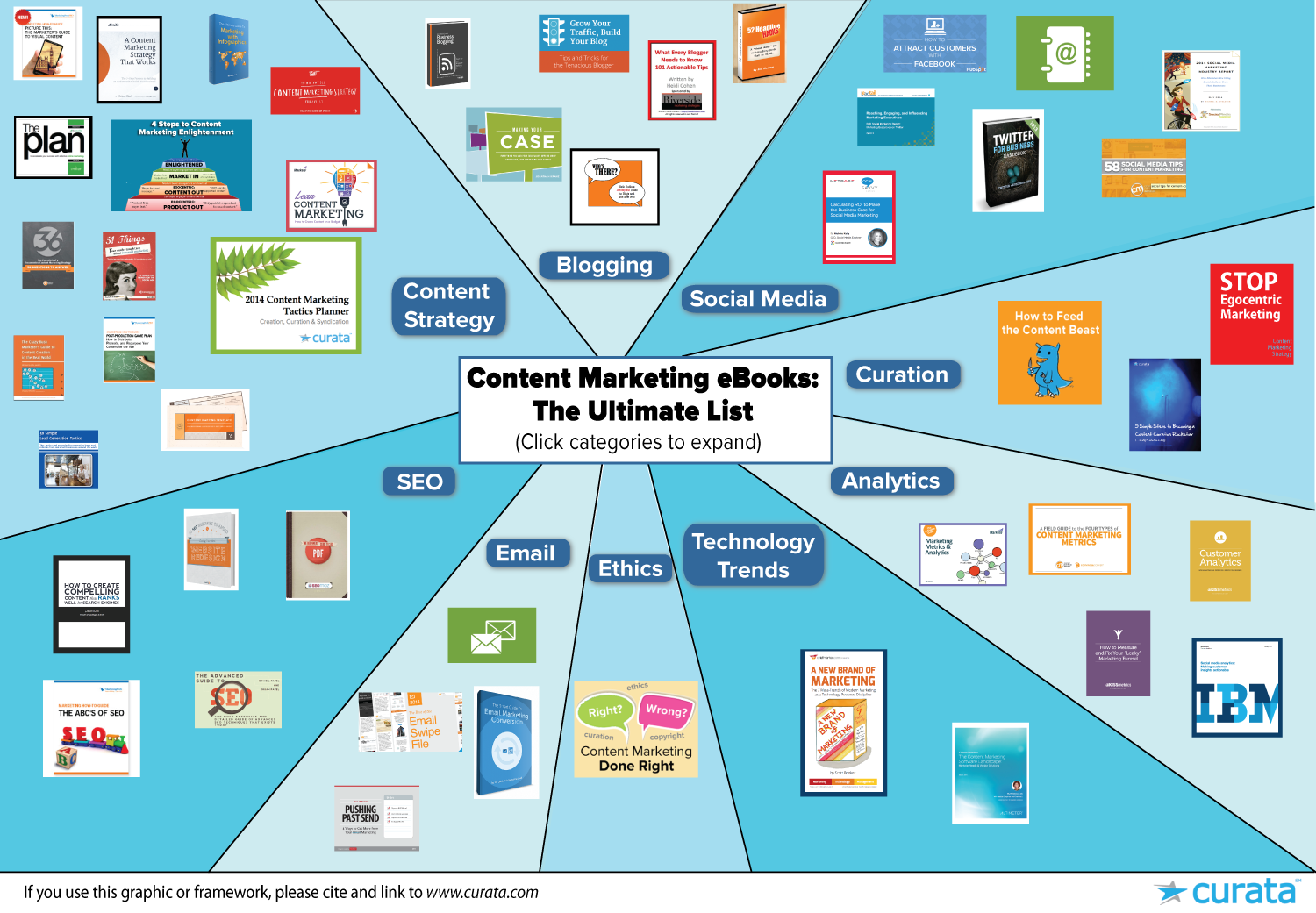
(Click here for the full-size image.)
Know any other great content marketing eBooks that have helped your company succeed? Let us know in the comments below.
CONTENT STRATEGY
- The 4 Steps to Content Marketing Enlightenment by Curata
Even with over 70 percent of marketers increasing their content spend this year, few will find success in overcoming content shock. This eBook provides best-in-class tactics and advice on how to become an enlightened content marketer.
 Arnie Kuen,
Arnie Kuen,CEO Vertical Measures, @ArnieKI am thrilled to see a new book from my friend Marcus Sheridan. Marcus and I have presented to thousands of people all around the world with the core theme of creating content that answers your prospects’ or clients’ questions. Research shows that when we go to buy something (B2B or B2C) we turn to a search engine 93% of the time. What do we do? We start asking questions. His new book is called “They Ask, You Answer,” and it will be a must have book for those of you rolling out content marketing at your organization.
- The Essentials of a Documented Content Marketing Strategy: 36 Questions to Answer by Content Marketing Institute
A great content marketing strategy is what sets one organization above another. This eBook helps marketers establish a documented content strategy to boost the effectiveness of their tactics as well as their budget.
 PAM DIDNER
PAM DIDNERCM Strategist, Speaker, Author, @PamDidnerI suggest A practical guide to killer marketing content from HubSpot. A very simple and easy-to-follow process with tips from knowing your audience to creating your editorial. It’s a nice way to get started. However, you need to test which content formats will work for your verticals, since every vertical’s customer journeys are different.
- Interactive Content Across the Buyer’s Journey by Ion Interactive
This eBook drills down into how to use interactive content. It addresses how interactive content can help you create better-educated prospects, and gives an overview of types of interactive content, their uses, and statistics supporting the effectiveness of interactive content. - Inspiring Customers to Create Content for You: A Marketer’s Guide by Influitive
Learn how to engage customers to create content for you. This eBook helps you save time and resources by getting customers to create content, increase the reach of content through customer’s social networks, and inspire customers to create valuable user generated content (UGC) on third-party websites.
 ANN HANDLEY
ANN HANDLEYChief Content Officer at MarketingProfs, @MarketingProfsThis Big Fat B2B Content Marketing Checklist from Velocity UK (shoutout to Doug Kessler!) is like 3,000 years old in Content Marketing Years (because each Content Marketing Year is like 825 years in the Gregorian calendar). But it’s nonetheless relevant and ridiculously useful today, and it’s timeless in the way that most classics are.
 DOUG KESSLER
DOUG KESSLERCreative Director & Co-founder of Velocity, @dougkesslerI’m going to have to be a shameless self-promoting click-slut here: I think every content marketer should have a strategy, so I’m recommending Velocity’s own Big Fat Content Marketing Strategy Checklist. It’s a simple, step-by-step guide that’s been used thousands of times by marketers who need to whip up a quick plan. (What? We’re proud of it! Sue me.)
- Post Production Game Plan: How to Distribute, Promote and Repurpose your Content for the Win by MarketingProfs
Your content strategy success depends on the readers it reaches. Extend the reach of content by distributing it through the right channels, promoting it to the right audience, and repurposing to get the most mileage out of it.
 CARLA JOHNSON Author of Experiences 7th Era of Marketing, Type A Communications, @CarlaJohnson
CARLA JOHNSON Author of Experiences 7th Era of Marketing, Type A Communications, @CarlaJohnson
Every B2B marketer should read Account Based Marketing: Fundamentals Every B2B Marketer Must Know from Demandbase. This eBook covers why it’s getting harder to engage customers during the increasingly complex B2B buying process, and forces you to be honest about why you’re not already making progress. They drive the point home that this isn’t just a marketing, or even sales, struggle. This is something that impacts the overall performance of the business. With a checklist and examples, it gives specific things that readers can learn and do right away.
- Picture This: The Marketer’s Guide to Visual Content by MarketingProfs
Images are a large part of storytelling. Learn how to use visuals to enhance your brand, drive engagement and connect with more customers in this eBook. - The Plan to Grow Your Business with Effective Online Marketing by Barry Feldman
Get pointers on how to create an effective, engaging website and best-in-class online presence. Learn how to attract customers with compelling site content in this quick read. - Lean Content Marketing: How to Create Content on a Budget by Marketo
Low on resources? No worries. This eBook will help you build a content team, reward content creation, get the most mileage out of awesome pieces and come up with winning ideas, all while on a budget. - How To Deliver Content Your Employees Will Love To Share by Dynamic Signals
There are a lot of content marketing eBooks out there on distribution. This book takes a different angle by focusing specifically on getting your employees to distribute. It covers how to choose topics your employees will want to share, how to distribute content to your employees, and how to make it easy for your employees to share your content. - Optimize: How to Attract and Engage More Customers by Integrating SEO, Social Media and Content Marketing by Lee Odden
Customers educate themselves with content throughout the buyer journey. Odden provides marketers with a customer-centric, top to bottom look at developing an integrated content marketing strategy, tactics for implementation, and insights on how to scale across the organization.
 MARCUS SHERIDAN
MARCUS SHERIDANKeynote Speaker & Author on Sales, Marketing, and Digital Business, @TheSalesLionI’d recommend “Content Marketing Works.” The company that produced it is an incredible agency with a tremendous amount of successful case studies of businesses that have dramatically increased their digital sales and marketing ROI by following the 8 steps in the book. If a company wants a step-by-step guide to content marketing success, then this is absolutely the place to start.
- Digital Relevance by Ardath Albee
Digital Relevance teaches readers the knowledge, strategies, and skills needed to create content, instantly engage customers, and compel them to take action by sharing ideas so seamlessly matched to each audience’s context that they can’t help but take next steps toward purchase. - A Content Marketing Strategy that Works by Copyblogger
Authority can make or break a content strategy. Find out how to attain thought leadership and provide the highest quality content for your readers with this guide.
 ARDATH ALBEE
ARDATH ALBEECEO & B2B Marketing Strategist, @ardath421Here’s my pick: Easy as Pie Guide to Content Planning – from Top Rank Marketing and DivvyHQ. The Easy as Pie Guide to Content Planning contains the components I find compelling in an educational eBook. It establishes the problem faced by its intended audience. It gives examples of what not to do. Then it shows you what to do with examples of how to do it. The eBook also includes insights from a few experts on each subject discussed for content planning. And the metaphor chosen is used well (recipes and cooking) with great visuals and white space to reduce the effort to read it. This is a recipe for a successful eBook that delivers on its promise.
- 51 Things Your Mother Taught You About Inbound Marketing by Chad Pollitt of Digital Relevance
How does Content Marketing fit into your overall marketing strategy? Find out in this eBook which dives deep into social media marketing, marketing automation, SEO and more. - Everything You Need to Build a Video Marketing Strategy by Vidyard
This video marketing strategy eBook gives a thorough breakdown of why video marketing is integral to your marketing strategy today. Topics covered include: types of videos you’ll want to produce throughout the funnel (and their strategic purpose), what a typical video marketing budget looks like (for in-house or outsourced assets), goals, strategy, analytics, and more.
BLOGGING
- Grow your Traffic, Build your Blog by The Daily Post (WordPress)
Struggling to build an audience? This guide provides advice and steps to make your content more visible, get more shares, and analyze the effectiveness of posts. - An Introduction to Business Blogging by HubSpot
If you’re a blogging novice this is a great asset. Find out how to pick your topic, which content to blog about, optimize posts, promote content, and measure its effectiveness in this eBook.
 LEE ODDEN
LEE ODDENCEO at TopRank Marketing, @LeeOddenI’d have to recommend: Everybody Writes (Ann Handley). Quality, not quantity is what drives great customer experiences and marketing performance with content. In her own smart and clever way, Ann takes readers on a journey to become the kind of content creator that people will actually care about. Everybody Writes is a go-to guide for creating effective content whether you’re a big business or small, experienced writer or a newbie. I can’t recommend it enough.
- 52 Headline Hacks by Jon Morrow of Boost Blog Traffic
Anyone can write a blog, but what makes one more popular than another? Headlines, for one thing, have a huge impact on whether or not a reader will pay attention to what you’ve written. Check out this eBook for advice on creating viral content. - Who’s There by Seth Godin
Not in love with the idea of blogging or maybe just don’t see the value? This eBook aims to convince you otherwise. Check it out to find out how a blog can be a great asset for you and your business. - What Every Blogger Needs to Know: 101 Actionable Tips by Heidi Cohen
Whether you’re new to blogging or not, this eBook is sure to have some new and inspiring tips and tactics you can put into action right away. Check it out if you want to give your blog a leg up.
 GINI DIETRICH
GINI DIETRICHCEO Arment Dietrich. Author of Spin Sucks, @ginidietrichI recommend “On Writing” by Stephen King. This was the first content marketing book written to help all of us become better writers. Though it’s written by a fiction author (and a great one at that), the things you glean from it will help your business storytelling at a deeper level. It’s so good, I’m having the communications firm side of my business read it for our January book club. Read it, mark it up, practice it, and read it again.
- Making Your Case by Jonathan Kranz of Kranz Communications
Want to write a compelling case study? This guide tells you how to highlight your successes and generate leads. - Business Blogging Secrets Revealed by Curata
Dive deep into the tactics of 425+ best-in-class business bloggers to see how they plan, execute, and promote their blog posts.
SOCIAL MEDIA
 HEIDI COHEN
HEIDI COHENActionable Marketer, Professor, Speaker, @heidicohenAs a content marketing eBook creator, contributor and consumer, I believe it’s crucial to evaluate the following eBook elements:
- Author/Source: Who wrote the book? What makes them an authority on the specific topic discussed? Who’s sponsoring the book?
- Reader value: Is this information worth my attention? Is the content worth an information exchange?
- Content: Does the eBook provided offer information that’s not readily available elsewhere? Or is it just promotional content parading as an eBook.
- Presentation: Is the content optimized to be reader-friendly? Can the reader consume it when, where, and on the device or app of their choice?
While I’m a huge fan of LinkedIn’s Sophisticated Marketer series of eBooks (especially The Sophisticated Marketer’s Guide to Content Marketing) and most of Rebecca Lieb’s research (especially Contently’s Content Methodology), the eBook that blew me away was Aaron Orendorff’s “50 Best Social Media Tools From 50 Most Influential Marketers Online.”
It’s not an eBook in the conventional sense. Or a PDF or Slideshare. It’s not gated. And it’s hiding in plain site on the Content Marketing Institute’s blog. BUT, it leaves even top quality content in the dust. Here’s why:
- It’s easy-to-consume information complete with visuals (hat tip: Venngage) and links to every tool, not just pushing a company agenda in return for reader data.
- This is quality content that shows readers how the experts use their tools. Every reader learns something from this content (I’m using it to expand my social media toolkit!) It’s no surprise that it’s a hot piece of content.
- It is inclusive. It’s not just the same influencers you see on every list. Further, it surfaces lesser-known social media tools.
- 25 Actionable Social Media Strategies You Can Implement Today By Buffer
25 social media strategies in one place, this eBook includes strategies for Twitter, Facebook, Pinterest, and more—all of which you can implement right away.
 PAM DIDNER
PAM DIDNERGCM Strategist, Speaker, Author, @PamDidnerRethinking the B2B Buyer’s Journey from Linkedin Marketing Solutions. I really like the chart on page 17. It shows the top three preferred content channels by buyers in each stage of the funnel. You can see how the importance of online search and social usage changes over the purchasing stage. It also compares the types of effective sales content among buyers, sales, and marketing. Although the information is not a complete surprise, it’s a great reminder to take into account the buyers’ journey when you create content.
- Reaching, Engaging and Influencing Marketing Executives: Actionable Social Marketing Insights by Leadtail
Having a hard time understanding which social networks you should be investing your time in? Check out how to reach the right people and improve your strategy with this eBook.
CURATION
Beginner
- 5 Simple Steps to Becoming a Content Curation Rockstar by Curata
Content curation is an excellent way to publish consistent and relevant high quality content for readers. This eBook is your guide for how to curate content effectively in under 20 minutes a day.
Intermediate and Advanced
- How to Feed the Content Beast by Curata
As a content marketer, you know that having, fresh, relevant content is the key to your success. But good content takes time. In this eBook, you learn how to balance and blend the two halves of content marketing—creation and curation. - Stop Egocentric Marketing by Curata
Readers want information on a variety of topics from diverse sources, but most marketers publish information in their voice only. This eBook provides insight into how to stop egocentric marketing and publish higher value content for readers. - The Ultimate Guide to Content Curation by Curata
This 80+ page guide, featuring over 30 marketing experts, teaches you how to create and analyze a content curation program.
ANALYTICS
- The Definite Guide to Marketing Metrics and Marketing Analytics by Marketo
This guide gives step-by-step information on how to measure the marketing metrics that matter using examples of Marketo’s own strategy. Check it out for help understanding which metrics to look at and how to interpret them. - The Marketing Landscape: Where Data and Content Merge by DiscoverOrg
This eBook includes information on the importance of market intelligence data, an optimized content creation process, and using account-based data. Use this eBook for a clear idea of why intelligent data is valuable and important to content marketing. - Social Media Analytics—Making Customer Insights Actionable by IBM
This report aims to help readers interpret social data so they can improve their strategies through consumer insights. Need help understanding consumer trends and your social impact? Give this one a read. - How to Measure and Fix your “Leaky” Marketing Funnel by KISSmetrics
Stuck on the marketing funnel? The best way to start improving your funnel is to measure it—then make the necessary adjustments. Download this eBook for advice on where to start. - Customer Analytics by KISSmetrics
People are the key to discovering what will improve your business. Find out how to cut through the noise surrounding your data and discover actionable insights about customers in this eBook. - A Field Guide to the 4 types of Content Marketing Metrics by Jay Baer of Convince and Convert
This eBook outlines 4 key categories of metrics that marketers can use to measure the success of their content. - The Comprehensive Guide to Content Marketing Analytics & Metrics by Curata
This eBook offers a comprehensive guide to the metrics that ensure your content marketing initiatives are effective and driving key business outcomes. As part of the journey, hear from over 20 of today’s top marketing experts on what they believe to be the most important content marketing metric. - The ROI of Great Content by Acrolinx
This guide promises to teach you how to double the impact of your content strategy. Acrolinx conducted a global survey to address the impact of quality on content marketing. It looks at how quality content impacts all aspects of marketing from brand to search traffic and beyond.
TECHNOLOGY TRENDS
 ANNA HRACH
ANNA HRACH Strategist at Convince and Convert, @annabananahrachMicro-Moments: Your Guide to Winning the Shift to Mobile. You can never go wrong with anything Google publishes, but this guide is absolutely amazing. It really shows just how much mobile devices have changed our lives and shaped the types of interactions consumers want and need from brands. Any marketer who wants to deliver truly helpful, meaningful and relevant content should read this guide today.
- The Content Marketing Software Landscape: Marketer Needs & Vendor Solutions by Rebecca Lieb of Altimeter
This eBook goes into detail on the use and effectiveness of various content marketing technologies and what tasks marketers need help with. Read this report if you need assistance finding your bottleneck or choosing the right tools. - Content Marketing Tools: The Ultimate List by Curata
Looking for a tool to help streamline your content marketing process? Although not in eBook format, this extensive list provides information on tools that help with everything from sourcing to measuring. - A New Brand of Marketing: The 7 Meta-Trends of Modern Marketing as a Technology-Powered Discipline by Chief Marketing Technologist
Technology is a large part of content marketing, and in order to succeed in the industry, it’s important to understand how technology and marketing intertwine. Check out this eBook for an understanding of the impact technology has on modern marketing.
ETHICS
- Content Marketing Done Right by Curata
Curated content means increased value for readers, improved thought leadership, and consistent, relevant content. If not done ethically it could do your business harm. Find out how to curate ethically in this eBook.
- An Introduction to Email Marketing by HubSpot
Great for beginners to create an email marketing foundation. This eBook includes the best practices for email as a roadmap to your email marketing success, and covers top challenges email marketers face and how to solve them - The Ultimate Guide to Email Marketing by Zapier
The eBook includes tips on the apps you should use to send every type of business email, along with ways you can integrate your email apps with other tools you’re already using, guidelines to make your emails great, and more. - The Smart Guide to Email Marketing Conversion by Unbounce
This eBook guides marketers on how they can amp up their email campaigns with targeted landing pages to increase conversions, grow subscriber lists and improve effectiveness.
SEO
- The Beginners Guide to SEO by Moz
If you’re new to SEO or maybe just need a refresher, this is the perfect eBook for you. Read this eBook to get started with creating high quality optimized content. - How to Create Compelling Content that Ranks Well in Search by Copyblogger
Looking for new tips, insights, and tactics for creating content that stands out above the rest? Check out this eBook for a step-by-step guide to writing compelling content for search. - 10 SEO Mistakes to Avoid During your Next Website Redesign by HubSpot
Redesigning an effective website isn’t always an easy task and takes a lot of thought and consideration. If you’re currently remodeling, check out this eBook to make sure you’re not making these SEO mistakes. - Beginner’s AdWords for Dummies: Keyword Research for SEO EBook by WordStream
Need help determining successful keywords? This eBook offers a bird’s eye view of keyword research, plus many more SEO tips and tricks. - The ABC’s of SEO by MarketingProfs
Most online activity begins with search, so you better make sure your content is hitting its SEO marks. Read this eBook if you need to create or update an SEO strategy with new tactics. - The Advanced Guide to SEO by Neil Patel and Sujan Patel
If you’re looking for advanced and extensive SEO detail, this is the perfect eBook for you. Check it out for the most up to date SEO information to employ in your content strategy.
Know of any other content marketing eBooks that provide valuable content marketing insights? Let us know in the comments!
For more ways to bolster your content strategy and benchmark your own content marketing efforts, download Curata’s 2016 Content Marketing Staffing & Tactics Study eBook.
]]>This infographic presents some results from Curata’s recent survey of 1,000+ marketers to hone in on what the leaders are doing from a strategy, staffing, and tactics perspective to kick ass with content. For a more in-depth presentation of the benchmark data and related guidance, download the entire eBook here: Content Marketing Staffing & Tactics Barometer.
The current phase of content marketing sees sector leaders no longer focused on pure content volume, or trying to hit the lottery with that one unicorn piece of content. These marketers are building the foundational elements of a practice that taps into the power of content to move an entire organization, versus simply a handful of people in a small corner of the marketing team.
Content marketing hype is coming to an end, indicating the beginning of its maturity across more organizations that will:
- Expand the strategic impact of content marketing efforts
- Fill skill-set gaps across teams
- Better leverage existing resources
- Get more rigorous on measuring content impact deep into the pipeline.
42% of Companies Have an Executive Responsible for Content Marketing Strategy
Expectations for growth of this senior role were high in 2015, with 49% of companies expecting to have a content marketing executive by the end of 2015. Growth has been slower than expected however. This role exists at only 42% of companies today, but is expected to increase into 2017.
Of the content marketing leaders, 53% have this role in place today, versus 32% for the laggards. Small companies with less than $10M in revenue, and large companies with $1 billion+ in revenue should see a 30% increase in staffing for the lead role in 2017.
Two thirds (68%) of these senior content marketing executives have global authority—a good sign given how important collaboration across an organization is for content creation and input, content reuse, and content distribution.
The Leaders’ Content Marketing Strategy & Tactics: Process
Leading marketers are focused on:
- Creating a content marketing strategy (step-by-step provided in this webinar)
- Performing regular content audits.
- Focusing content creation on segments and accounts. (e.g., account-based marketing)
- Reusing content. (e.g., using the Content Marketing Pyramid as a framework)
- Creating and curating content.
- Measuring content’s impact.
A common theme among marketing leaders is stretching the dollar. They’re asking themselves:
- What content do I already have?
- How can I reuse and repurpose content?
- How can I collaborate and curate?
Analytics
Content marketing leaders are laser-focused on measuring the impact of content to justify its impact on the organization, as well as to drive continuous improvement. The leaders also get that content impacts the top, middle and bottom of the funnel if done right.
Content marketing has had the greatest impact on the top of the funnel (TOFU) so far. However, the leaders see significant impact on MOFU & BOFU as well. They look at metrics across the funnel, from leads generated and influenced at the marketing-owned stages, to sales opportunities generated and influenced.
Time to Raise the Performance Measurement Bar
Data-driven content marketing is possible and can yield significant results. For example, Curata used its own content marketing platform integrated with Marketo and SF.com to discover long form blog posts generate nine times more leads than short form blog posts, as we discussed in this blog post. Investing in marketing technology makes this process possible.
Summary:
Content marketing should impact all stages of the pipeline. The leaders get this, and as a result content marketing is entering a new phase of maturity.
- Build your content team: both internal and external. Take a Center of Excellence approach.
- Identify opportunities to stretch your content marketing budget such as repurposing, reusing, and curating content.
- Raise the performance measurement bar to go beyond measuring page views and social media. Dive deep into marketing pipeline impact and sales pipeline impact (examples here).
- Tap into the power of content marketing technology: Establish a closed-loop content supply chain, and integrate it with marketing and sales automation (the content marketing platform complements marketing salesforce automation). And above all, don’t forget to have fun with it!
A classic example is Old Spice’s “The Man Your Man Could Smell Like.” After this video launched in February 2010, the brand’s total sales increased by more than 100 percent over the following five months—and all Old Spice had to do was sit back and watch as millions of consumers spread the word about their product.
This is viral content at its best, but it left many companies with a burning question: ‘Can we produce something similar, and if so, how can we integrate it into our existing marketing strategy?’
New research from content marketing agency Fractl says anyone can, so long as you create content that triggers a highly emotional response—an essential ingredient that drives both engagement and shares. (Disclosure: Fractl is my employer, and some of the examples discussed involve Fractl campaigns.)
Why does emotionally provocative content work? An emotional response creates a personal connection to the content in question, which helps you earn attention organically. This type of response is common to highly viral content, but there’s more to it than simply producing a video that makes someone happy or sad.
In their book Made to Stick: Why Some Ideas Survive and Others Die, brothers Chip and Dan Heath offer six important components to an idea that resonates—which apply equally to viral content. They argue sticky ideas are Simple, Unexpected, Concrete, Credible, Emotional, and generates Stories (or SUCCESs).
Below I’ll walk through how each of these principles can be incorporated into campaigns to help take your existing marketing strategy to new, more viral heights.
1) Forget all the bells and whistles: stick to producing simple ideas
The good news is viral content tends to be incredibly simple, so increasing the viral potential of something doesn’t require a complete overhaul—more just eliminating the fluff.
Remember Ellen DeGeneres’ now infamous Oscar selfie? Turns out it wasn’t as spontaneous as we thought. Samsung’s Chief Marketing Officer told Adweek it planned to have Ellen take a selfie with Meryl Streep using one of the brand’s smartphones. It’s an incredibly straightforward idea that was on brand and required only a smartphone to execute—and little did they know it would end up becoming the most retweeted selfie of all time.
If only Bradley’s arm was longer. Best photo ever. #oscars pic.twitter.com/C9U5NOtGap
— Ellen DeGeneres (@TheEllenShow) March 3, 2014
2) Break through the noise with controversial or unexpected content
This one is a bit trickier to implement as most brands have a very rational desire to protect the image they’ve worked so hard to cultivate. The thought of attaching your company to anything controversial can set off alarms, but polarizing doesn’t have to mean a swarm of Internet trolls and bad press; it can actually start conversations and provoke reactions from more than your target audience—something essential to viral success.
However, when testing controversial waters, keep these three things in mind if you want to stay afloat:
- Your idea needs to be connected to your brand in some way. Something shocking will go nowhere if it doesn’t offer some sort of value to your consumers.
- Although there’s no guarantee your content will avoid backlash, you can prepare a calm and collected response to any potential discrepancies ahead of time.
- It pays to include other high share-worthy elements, like comparisons or geographically-focused data.
Consider this campaign by Fractl client ABODO. The site serves as a one-stop shop for visitors looking for a new apartment, but it’s not necessarily the most interesting vertical (who wants to read about square footage?). However, this campaign examined an often overlooked element when relocating: your compatibility with an area’s culture and values. With Twitter’s help, tweets from regions across the country were pulled to locate the most prejudice and derogatory language.
Bigotry in America is an extremely sensitive topic, but the risk paid off. This polarizing topic generated a ton of engagement, which helped the company earn more than 620 placements along with over 67,000 social shares.
3) Humans are sensory learners, so use striking visuals to increase viral potential
Nearly 50 percent of marketers believe visual content is essential to their marketing and storytelling strategies. If you want people to pay attention to your content, you need a compelling visual—especially if you want to generate social shares.
Dove took this idea to heart in their highly successful “Real Beauty Sketches” campaign. The clip follows a series of women who describe themselves to a forensic artist as they wait patiently for a final portrait. The artist then creates another portrait for each woman, this time based on a stranger’s account of their looks. In most cases, the sketches based on the stranger’s perspective resulted in a more accurate and flattering portrait compared to those based on the women’s own descriptions.
This campaign worked because it relied heavily on visuals (earning more than 67 million YouTube views to date), capitalizing on video as a unique visual medium. When you consider 64 percent of consumers who view a video are more likely to purchase the goods or services advertised, this was a huge home run for Dove.
4) Viral content lets you position your brand as an industry leader, so boost authority through credible data
The massive exposure associated with virality is also a great time to try and “own” your niche. Viral content can create a lasting impression; make it a good one by ensuring your brand is reliable and credible.
Intel executed this concept perfectly in its “Meet the Makers” video. The clip features 8th-grader Shubham Banerjee, who invented a much cheaper Braille printer—brought to life with one of Intel’s processors. Not only is it an incredible story, but the video highlights how Intel is a trusted source in the tech industry because it’s used in such progressive products. This was further emphasized when the voiceover reminds viewers the printer is helping more than 200 million people to see. The final kicker to credibility? The video concludes by showing the printer in action.
5) Highly emotional content is essential to any viral marketing strategy, and can be boosted by timeliness
A key element to viral success is igniting an emotional response, and an excellent way to incorporate this into your existing strategy is to promote content around emotional events such as holidays.
A great example is Pandora Jewelry’s “The Unique Connection.” Released just before Mother’s Day, the clip celebrates the connection between mothers and their children by highlighting how blindfolded children can still identify their mothers simply by touch. It’s an incredibly moving video, specifically because it taps into one of the top viral emotions: love.
6) Your content also needs to tell a story—preferably more than one
Another easy way to up something’s viral potential? Find ways to make the content fit more than one vertical.
In this study conducted by one of Fractl’s clients, FitBit earned a ton of traffic from various sources. However, what worked well for them is the diverse link portfolio they’ve generated thanks to how many verticals identify with their content. Of the top 30 sites that link to FitBit, more than a third are articles from health blogs and over a quarter are from tech gadget blogs, as shown below.
The lesson? Creating content that crosses seamlessly between different audiences helps push more people to your site—where you can promote more gated content for conversions.
Final thoughts
Content marketing is a highly effective way to drive traffic to your business, especially if you can create a viral hit. Keep in mind that although there are many factors that influence what someone shares online, the SUCCESs model points to key six elements—including striking visuals and emotional stories—essential to any successful viral marketing strategy. To learn more about crafting an effective content marketing strategy, download The Content Marketing Pyramid: A Framework to Develop & Execute Your Content Marketing Strategy.
]]>The following marketing thought leaders shared their insight with 300 of Boston’s marketers:
- David Skok, GM, Matrix Partners @BostonVC
- Brian Balfour, VP, HubSpot @BBalfour
- Heather Loisel, VP, SiriusDecisions @HeatherLoisel
- Damian Roskill, VP Marketing, uTest @droskill
- Michael Yaffe, VP Marketing, Beyond Trust @BeyondTrust
- Justine Jordan, Mktg. Director, Litmus @litmusapp
- Alan Belniak, Content Expert, @abelniak
- Jonathan Burg, Dir. Demand Gen., Apperian @Jonmburg
Key Take-Aways
- Reduce the time to WOW for your buyers with Growth Hacking.
- Tap into engineering for better marketing.(e.g., free trials, free tools)
- Identify and eliminate bottlenecks in your buying process to reduce friction and increase conversion.
- Hire a set of developers in your digital marketing team to enable innovation.
- Break down the barriers between marketing and sales. (e.g., post your funnel diagram on the wall, ask sales to bcc marketing for buyer questions(this last one I pulled from a recent Social Media Marketing World wrap up))
All insight is sourced, paraphrased and quoted from the respective individuals, except for my personal comments which are in [brackets].
The Art & Science of Growth Hacking
David Skok, GM, Matrix Partners @BostonVC (www.forentrepreneurs.com)
- The customer is doing their research before they come and talk to you. [A reminder for us marketers that with all of the free information available online today(e.g., peer-to-peer communities, free trials, independent product reviews), our online presence matters more than ever. . . Content Marketing)
- A new combination of skills is required for marketers to become “growth hackers”. Some of these skills along with related best practices include:
- Funnel optimization: Understand your buyers’ journey as they pass through the stages of awareness(ToFU), consideration(MoFU) and purchase(BoFU).
- Metrics: At the simplest level, evaluate flow/quantity and conversion rate through your funnel. (check out Adobe’s content marketing and social media KPIs in this post)
- Put a diagram of your funnel on the walls of your company to help get marketing and sales on the same page.
- Identify and resolve blockage points in your funnel. [Develop a process flow diagram as part of a root cause analysis to determine where the bottlenecks are in your process to optimize flow and conversion rate through your pipeline.]
- Here’s a good example of Growth Hacking in action: HubSpot’s website grader uses engineering for marketing
- You can access David Skok’s full deck on SlideShare: The Art & Science of Growth Hacking
- Check out what David Skok has to say about what it takes to be an A+ CMO: SaaS Marketing Insights for CMOs
Growth Hacking for Marketers Panel Discussion
Panelists: Justine Jordan @litmusapp, Damian Roskill @droskill, Brian Balfour @bbalfour, Michael Yaffe @BeyondTrust
- “Free trials have been extremely successful, with a 40-60% conversion rate. Adding more friction into the buying process results in a 10X increase in cost.” @litmusapp
- Here are some great reasons why you can’t rely on “one-off” tactics to optimize marketing ROI – instead, rely on process: (@bbalfour)
- What works for other won’t work for you.
- Growth is the sum of a lot of small parts. [i.e., There’s no one silver bullet.]
- Rate of change is accelerating, such as SEO, channels for building awareness.
- You need a machine(and not one thing) that is scalable, predictable and repeatable.
- @bbalfour has a set of developers in his marketing organization to enable more advanced marketing. @droskill also has developers as part of the marketing organization.
- Michael mandated that all marketing qualified leads met strict criteria(e.g., company size, buyer role) regardless of the fact that it resulted in a significant decrease in the number of leads sent to sales. @BeyondTrust
The Transformation of B2B Sales, Marketing and Product
Heather Loisel, SiriusDecisions, @HeatherLoisel
- If you’re not using the SiriusDecision’s Demand Waterfall already, start now [Slide #2]
- You can’t get to “growth” without taking risk, and you need marketing transformational change to catalyze this process
- If your budget allows it, do check out their upcoming Summit in Florida, May21-23
- You can access the full deck on SlideShare: The Transformation of B2B Sales, Marketing & Product (including an overview of seven of their new models, with frameworks from marketing to teleprospecting to sales)
Creating a Content Strategy to Align with the B2B Funnel
Alan Belniak @abelniak and Jonathan Burg @Jonmburg
- Content marketing is not just for the marketing part of the funnel.
- Tap into the power of different content delivery channels based on your buyers’ needs. (e.g., a podcast is great if your buyers are stuck on a train each day for their commute.) @abelniak
- “Audit the heck out of your content to identify gaps and determine options for better repurposing.” @Jonmburg [check out the Content Marketing Pyramid framework to help optimize content use and ROI]
- Align your content audit by: ToFU(Top of the Funnel), MoFU(Middle of the Funnel) and BoFU(Bottome of the Funnel); theme/campaign, persona, etc. Include content success as part of the audit.
Did you hear any other great insights at this MassTLC event? Catch anything interesting on Twitter? Let us know in the comments below. Interested in other content marketing related events in the coming year? Check out our list here.
]]>
Identifying Challenges
Several of the experts we talked to cited sustaining content creation over the long haul as a key challenge. Jeannine Rossignol, VP marketing communications at Xerox, says the initial challenge was understanding their brand’s target audience and what was important to that audience. Then came the task of maintaining the flow of content. “How are we going to sustain it so it’s relevant, engaging, and targeted?” she points out.
Often, content creation is delegated to only one or two employees who many burn out over time due to the constant need to feed the content beast, points out Lee Odden, CEO of TopRank Online Marketing. “Folks can feel like they’ve run out of ideas,” he says.
Jon Miller, VP of Marketing and cofounder at Marketo, echoes this point, adding that it’s also challenging to create compelling thought leadership that says something new to elevate your brand. He also mentions the difficulty of “creating enough variety and types of content to engage broad audiences at different stages of the buying cycle.” This relates directly to how marketers focus too much on talking about themselves and their own brands, supporting the notion to stop egocentric marketing.
Developing Solutions
But while these companies face similar challenges, their marketing pros have different approaches to overcoming them. Rob Yoegel, Content Marketing Director at Monetate, stresses the importance of hiring someone with writing abilities and subject matter knowledge rather than simply hiring a journalist to tackle content marketing.
Rossignol says when Xerox examined the company’s case studies, they realized that they weren’t telling them from the customers’ perspective. Instead of writing up case studies in a challenge/solutions/results template, they started interviewing customers more and inviting them to blog about the issues they’re facing. The result? Now it’s completely from their perspective. This approach is a great content marketing technique to provide different opinions, and to market your brand through the voice of your customer. Combining both the company perspective and the customer prospective allow the buyer to understand the full breadth of your offering.
Miller suggests approaching content marketing from multiple angles: creating your own content, reaching out to third-party writers through online marketplaces, and curating content. “Go out and find really good content, and curate it with your own commentary to create a holistic view of all the different kinds of content you might want,” he says.
Of course, “any content a brand publishes should be aligned with its customers”, as Odden points out. “Tap into the stories that will connect with solving problems for customers and at the same time communicate the value you bring as a brand,” he says. Communities can be “never-ending sources of ideas to fuel your content marketing efforts.”
Using Curation to Address Content Marketing Challenges
Several of these experts stressed the importance of content curation as part of a best-in-class content marketing program. Miller says it’s especially useful during the relationship-nurturing phase. As an example, he mentions someone he’s known for a couple of years who periodically sends links to articles in the New York Times or the Economist and adds a little bit of his own commentary. “It’s an incredibly powerful way to maintain the relationship,” Miller says. Curation is also helpful in reaching multiple customer personas at multiple stages of the buying process.
Curation plays a critical part in content marketing’s goal to become a publisher in your target market, according to Yoegel. “Your can’t do it all,” he says. “You have to curate the best content from different websites and publishers and put that out to your customers.”
When Xerox began publishing a new magazine around the theme of optimism, Rossignol says the company partnered with Forbes to “help tell the story and give us permission to play with our targeted audience.” She says the combination of the original and curated content “gives our prospective clients a fuller picture” of the topics they read about.
Are you faced with similar challenges at your organization? We’d love to hear from you and learn how you overcame your content marketing challenges. Please post a comment below or drop us a line at [email protected] and we may feature you in an upcoming post.
Who doesn’t love a little content marketing coverage?
]]> As much as I love and depend upon inbound marketing (e.g., content creation and curation as part of Curata’s content marketing strategy), I am occasionally reminded that there really is still a place for traditional outbound marketing in B2B technology. In addition, old school segmentation and targeting can help make it quite effective. My most recent encounter with this alleged dinosaur (i.e., outbound marketing) was on the Red Line subway in Boston.
As much as I love and depend upon inbound marketing (e.g., content creation and curation as part of Curata’s content marketing strategy), I am occasionally reminded that there really is still a place for traditional outbound marketing in B2B technology. In addition, old school segmentation and targeting can help make it quite effective. My most recent encounter with this alleged dinosaur (i.e., outbound marketing) was on the Red Line subway in Boston.
As I was enjoying the view of the Charles River during our train’s crossing of the Longfellow Bridge, a poster ad in the subway car caught my attention. This wasn’t your traditional subway ad for a bank, college or language course. It was an ad for technology that will help you advance your genetic research by life Technologies, recently acquired by Thermo Fisher Scientific. As a former chemical engineer, I did find this ad interesting. However, why in the world would they have this ad in the subway? Does the average Boston tourist or subway commuter get involved with genetic research? Perhaps this ad was put there by mistake by some marketing agency or T employee?
After further thought, I realized that placement of this ad was quite strategic since the Red Line passes right by Mass General Hospital. That means hundreds if not thousands of medical professionals involved in the use and/or purchase of genetic research products pass through this subway each week. Now I can’t be too sure about the ultimate ROI of this ad. However, I do give the marketer responsible for its placement credit for resorting to “old school” marketing for such a high tech product. This is exactly the type of innovative, and “against the grain” thinking that’s needed to rise above the noise in today’s digital economy.
]]>“Marketers are realizing they can’t just create a one and done content campaign,” Handley says. “It becomes a lifelong effort creating the kind of content that’s going to engage your customers, that’s going to delight them.”
While advertisers can take a set it and forget it approach, content marketing requires ongoing work. “The biggest challenge is finding the time and doing the work,” Volpe says.
Savvy organizations are meeting these challenges in a few different ways. Volpe mentions the importance of choosing a few effective content marketing tools to streamline your time instead of taking the duct tape approach, while Handley stresses the growth of staff roles like chief content officer, director of publications, or editorial director. “They’re hiring people to drive that bus, to create engaging content, and to build audiences,” she says. “They’re finally putting the systems in place that are allowing them to create engaging content.”
Moyle takes a purposeful and disciplined approach to content strategy where he sits down with keywords and cranks out 30 blog titles to work on in the coming weeks. “There’s no such thing as writer’s block,” he says. “You just have to do it.”
Not surprising, the three marketers see content curation as an increasingly vital part of content marketing. “It’s hard to create enough of your own original content to be able to tweet 15-20 times a day,” Volpe says. “Having curated content that you can publish helps because it’s things that they’re going be interested in. I think curation can be a really important part of your overall inbound marketing strategy.”
But as Moyle points out, curation is not about aggregating other people’s content. Curation is about adding value for your own readers by identifying the best and most relevant content for your audience, selecting main points from the content you’re curating, and wrapping own insight and guidance around that. “The smarter we get, the better our tools are, the more we can do that in a regular and ethical and respectful way,” he says.
Handley uses curation not only to share content but also to get a pulse on emerging conversations and trends. “I use it to listen … to see what else other people are publishing,” she says. “What are the hot buttons for marketers? It’s a way to prospect socially through your content to create more content that’s engaging.”
Do you agree? Do you have similar challenges? We want to hear from you – leave us a comment and let us know.
]]>
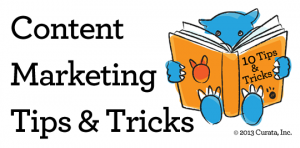 In an AMA webinar I hosted with Rick Burnes at HubSpot, a third of attendees said time to do it was the biggest challenges they faced in creating content. A quarter said having staff to create content was their biggest challenge. Creating content doesn’t have to be this hard. Here are some content-creation strategies that were shared:
In an AMA webinar I hosted with Rick Burnes at HubSpot, a third of attendees said time to do it was the biggest challenges they faced in creating content. A quarter said having staff to create content was their biggest challenge. Creating content doesn’t have to be this hard. Here are some content-creation strategies that were shared:
-
Get into the content mindset. Anytime you’re thinking about your business or industry, be looking for inspiration. Could the discussion you had in a marketing meeting last week be turned into a blog post? Could that answer your colleague posted on Quora? What about that presentation you gave at a conference last month? Look for these kinds of opportunities.
-
Create tweetable facts. Compile a list of statistics and include a “click to tweet” link next to each one. Include the link back to the original post. Here’s an example called 10 Tweetable Facts from 2nd Annual B2B Marketing Trends 2012 Report. This strategy creates multiple entry points into a blog post and allows readers to easily tweet the stat they find most interesting. The ease with which readers can share your content boosts the potential for it to go viral.
-
Don’t be Hemingway, just be useful. A lot of people who are new to content marketing try to turn their content into an art form. This places a ton of pressure to craft the Great American Novel or something worthy of a National Poetry Award, and it’s not necessary. If you find yourself getting sucked into this mindset, simply ask yourself, “Will my target customer find this useful?” If the answer is yes, you’ve done your job.
-
Conduct a poll or survey. Write a blog post and ask readers some questions about your topic. Then you can take the responses and craft another blog post, so you’re getting two pieces of content out of one idea. For instance, Boston.com’s Daily Dose blog published a reader poll to tie in with new research on headphone-related accidents.
-
Don’t make one person carry the load. Often at companies, the blog manager will carry the whole load of the blog, which isn’t scalable. Instead, find creative ways of enlisting people throughout the company to contribute to the blog. At Hubspot, 130 out of 300 employees blog and they give awards to the top bloggers. Take advantage of people’s vanity or competitiveness to motivate them.
-
Create guest blog posts. Invite a guest blogger to write on your site or contribute guest posts to another site. When you publish guest posts, it’s an easy way to create content with minimal effort. When you contribute a guest post yourself, it exposes you to a new audience and boosts your SEO. For instance, here’s a guest post I wrote for HubSpot about curating B2B content.
-
Re-use your best old content. Repurposing content you’ve already created is far easier than creating brand new content. Another variation on re-publishing older content is taking it through the content marketing pyramid. If you have a 20-page ebook, chop it up into 20 blog posts. Or you could take 20 blog posts and turn them into an ebook.
-
Conduct an interview. The beauty of interviews is that it requires minimal time and effort to email an expert in your industry, type up questions, and clean up their responses before publishing. However, your interview subject gets exposed to a new audience and gets the SEO benefits of links, while you get to expose your readers to a new perspective. Here’s an interview with Craig Zabodijnk, Marketing Manager at DPT Labs who sends out a regular curated email where he discusses his curation methods.
-
Create an infographic. Infographics have a far reach and are easy to embed on other sites, which creates the potential for your content to go viral. Include your brand’s name and logo and make the infographic available under Creative Commons so others can easily share it, giving you more exposure. Here’s an example of an infographic from Eloqua about the content grid.
-
Test your content. Don’t rest on assumptions of what types of content works. Test those assumptions to make sure that you’re not killing yourself over content that won’t get read as much as another type of content. You might assume that your readers would enjoy video clips, but videos are time- and resource-intensive to produce, so if cartoons require less effort and get much more clicks from readers, you should do that instead.
I hope you enjoyed this post. I wanted to also invite you to join our  upcoming AMA webinar on August 20th 1pm EST to learn how to Optimize Your Lead Nurturing Process: The Right Content to the Right Audience. Register and reserve your spot >>
upcoming AMA webinar on August 20th 1pm EST to learn how to Optimize Your Lead Nurturing Process: The Right Content to the Right Audience. Register and reserve your spot >>
An Overview of LinkedIn’s Content Moves
I have put together an infographic (below) that summarizes some of LinkedIn’s major moves with regards to content. Here’s a quick rundown:
March 2011: LinkedIn Launches “LinkedIn Today”
In March of 2011 (and even today), very little content was created and hosted on LinkedIn. To get users to turn to LinkedIn as a source of content, they relied on curation so they did not have to build a large publishing team. Linkedin made their foray into content with the launch of LinkedIn Today.
While LinkedIn does not host a lot of content, a lot of content passes through their network in the form of links shared in status updates. LinkedIn employed social curation by mining these links and publishing a curated section of their site with the most popular articles for each user’s specific industry. If you’re on LinkedIn, you likely are receiving this already.
March 2012: SlideShare Acquisition
A year later, LinkedIn made their first major content-related acquisition by adding the “YouTube for Slideshows” — SlideShare to their portfolio for $87 million. The SlideShare acquisition made sense for LinkedIn for two main reasons:
-
Overnight LinkedIn acquired millions of pieces of content to inject into their ecosystem.
-
While videos and picture content is attractive for Facebook users, and music is attractive for MySpace users, presentations are attractive for LinkedIn’s professional audience.
October 2012: Influencers and Blogging
Six months later, LinkedIn quietly rolled out the ability for a set of 150, hand selected influencers to create content on their site. These influencers have really been the cream of the crop from respected individuals in the business world such as Bill Gates and Richard Branson. For the first time, users could create content directly within and hosted by LinkedIn. LinkedIn plans to aggressively expand this ecosystem as reported in a recent New York Times article.
April 2013: Pulse Acquired
Right around the time of Yahoo’s acquisition of news summarization app, Summly, and Google’s news aggregation app, Wavii, LinkedIn announced their acquisition of news sharing application, Pulse, for $90 million. Though LinkedIn has not fully incorporated the application within the LinkedIn experience, we should expect them to use this to enhance their content presence on mobile and tablet devices.
Why is LinkedIn so interested in Content?
So why is LinkedIn doing all this? Why are they investing hundreds of millions of dollars in freely available content that’s not directly monetizable?
It’s because LinkedIn fundamentally lacks user engagement. In a recent talk by Geoffrey Moore, author of Crossing the Chasm, he described the four gears that drive any online consumer company: acquisition, engagement, monetization, and activation.
-
Acquisition is the ability to acquire new users. LinkedIn excels at this and has one of the largest social networks online.
-
Monetization is the ability to extract revenue as a result of that user base. Whereas Facebook has issues with this, LinkedIn does not; with Premium subscriptions, recruiter tools, and sales tools.
-
Activation is the ability to get your user based to proactively recruit other users to fuel monetization and acquisition. LinkedIn users have been very active in growing their own networks and as a result the network overall.
-
Engagement is the ability to keep the user base involved and active on your properties post acquisition. This is where LinkedIn has been lacking.
Think about it. What do you usually do on Linkedin? If you’re like me, then you go to the site to: (1) check out and search for profiles, (2) reply to messages and invitation requests, and (3) occasionally interact in groups. Compare that to Facebook, where users can spend hours on end. In fact, the average American spend 59x more time on Facebook than on LinkedIn.
Lessons Learned
There are a few immediate lessons from LinkedIn’s strategy that can be employed by marketers:
-
Use Content for Engagement. Similar to how LinkedIn is employing content to increase engagement, you can do the same to increase prospect engagement with your brand. By creating engaging and relevant content, you can drive your customer acquisition, activation, and monetization.
-
Use Curation to Bootstrap. LinkedIn’s first step into content was not to build an editorial team or to try to become a media company. Instead, they curated third party content to start. While LinkedIn used social curation by harvesting content shared by millions of users, you can get started with curation without such a user base by curating content as an authoritative topic expert.
For more resources on how to get started with content marketing and content curation, you may be interested in our award winning eBook 5 Simple Steps to Becoming a Content Curation Rockstar. Or if you’re already familiar with content curation and want some further inspiration beyond LinkedIn, check out the 2013 Content Curation Look Book featuring real-world brand examples of curation. Lasty, if you’re on LinkedIn and you’re looking to connect with other content curators, join the Content Curators group.
]]>